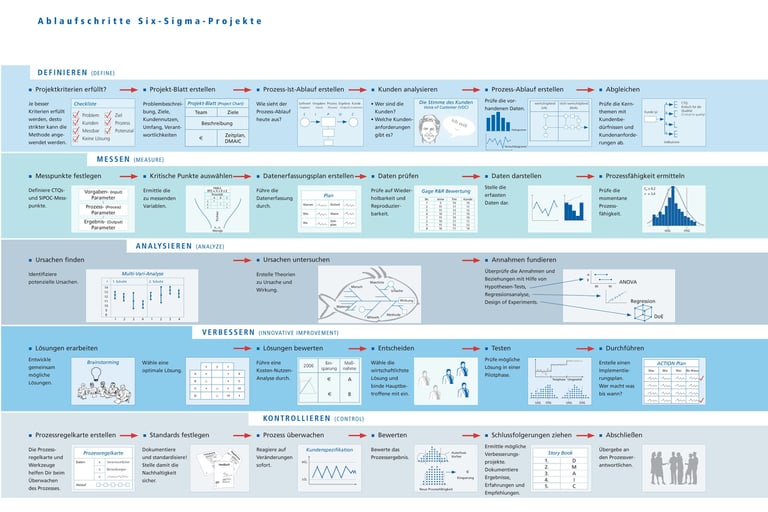Better from Experience

Lean management is used to reduce waste. Six Sigma continuously improves quality
LEAN Speed and SIX SIGMA Quality
Lean management and Six Sigma (Lean Six Sigma) are world-class methodologies that play a critical role in achieving and maintaining competitiveness in today's fast-paced business environment. While each framework offers distinct benefits in isolation, their combined application can lead to unprecedented efficiency and significant performance improvements.
Lean Management: Lean management focuses on maximizing value by minimizing waste—be it time, resources, or materials. This approach originates from the Toyota Production System, which emphasizes continuous improvement (Kaizen) and respect for people. The main goals of lean management include: 1. Identifying value: Understanding what customers truly value promotes focused efforts and eliminates redundant processes. 2. Mapping the value stream: Analyzing the flow of materials and information helps identify inefficiencies and enables companies to streamline operations. 3. Creating flow: Ensuring smooth and uninterrupted process flow promotes efficiency and faster response times. 4. Establishing pull: Implementing a pull-based system helps produce only what is needed, thus reducing excess inventory and waste. 5. Striving for perfection: A culture of continuous improvement motivates employees at all levels of the organization to seek opportunities for innovation and advancement.
Immerse yourself in Six Sigma: On the other hand, Six Sigma aims to improve quality by identifying and eliminating defects and deviations in processes. Six Sigma uses a data-driven statistical approach that measures and analyzes processes to improve performance. The key elements of Six Sigma include: 1. Define, Measure, Analyze, Improve, Control (DMAIC): This five-step methodology guides companies in problem-solving and process refinement. 2. Focus on Customer Requirements: Six Sigma emphasizes understanding customer needs to ensure that improvements are accompanied by increased customer satisfaction. 3. Data-Driven Decision Making: By leveraging data analytics, companies can make informed decisions, thus increasing precision in identifying areas for improvement. 4. Reducing Variability: Controlling and reducing variations leads to greater consistency in products and services and has a positive impact on quality. 5. Employee Empowerment: Training and engaging employees at all levels ensures a collaborative approach to improvement initiatives and promotes a culture of ownership and accountability. The Synergy of Lean and Six Sigma When used together, Lean and Six Sigma provide a comprehensive framework for driving operational excellence. The integration of these methods leads to numerous benefits: 1. Increased efficiency: Lean's focus on eliminating waste complements Six Sigma's quest to reduce defects, resulting in optimized processes that run more smoothly. 2. Improved quality: The combination of Lean practices and Six Sigma's emphasis on quality control helps companies continuously deliver high-standard products and services. 3. Faster problem resolution: The structured methods of both approaches enable rapid identification of root causes and lead to effective solutions. 4. Increased employee engagement: Empowering employees to contribute to Lean and Six Sigma initiatives fosters a culture of innovation and continuous improvement. This engagement not only boosts morale but also leads to greater operational success. 5. Customer satisfaction: Ultimately, the primary goal of Lean Management and Six Sigma (Lean Six Sigma) is to increase customer satisfaction. By streamlining processes and delivering high-quality products, companies can gain and retain loyal customers.
In summary, the combination of Lean Management and Six Sigma (Lean Six Sigma) represents a powerful approach to achieving and maintaining competitiveness in today's dynamic marketplace. By leveraging the strengths of both methodologies—eliminating waste through Lean practices while emphasizing quality through Six Sigma—companies can achieve significant improvements in efficiency, quality, and customer satisfaction. As companies continue to address the challenges of the modern landscape, the effective integration of these methodologies will be critical to building and maintaining a competitive advantage.








